Today I'm looking at Denbigh Mental Asylum, more modernly known by the more politically correct but less exciting title "North Wales Hospital." And I know what you're thinking. What took me so long?
For years, I actually put off going here purely because I felt it had been done to death. You're almost guaranteed to come across other adventurers while exploring it. It's practically a tourist attraction. You'll find photos of this place all over the internet, dating back to its initial closure, and many urban explorers come here when they're just starting out. So really it's quite a surprise that I've only now decided to get around to it, after almost a decade of climbing churches, rope laddering into abandoned gyms, running from security and almost dying.
How wrong I have been. Denbigh Mental Asylum is the urban exploring equivalent of dropping your kids off at the playground. It's truly amazing! Every visit has a new discovery, and one cannot stroll around the site without finding themselves spoiled for choice. And with its sad history of recent arson attacks, and the councils plans to demolish chunks of it for housing, I realised it was now or never. If this place was suddenly gone forever, and I never visited when I had the chance, I would regret it. So in all my obsessive glory, I dedicated a vast quantity of time to Denbigh Mental Asylum, and probably didn't even see it all. Nevertheless, I had a darn good try, and here it is.
This building is huge, and this is just the tip of the iceberg. Beyond this building is a labyrinthian complex of intersecting hallways, additional wards, underground tunnels, and about fifty billion ways to die.
The story of Denbigh Asylum begins in 1842 when it became apparent that something needed to be done to improve the quality of life for Welsh lunatics.
At the time, Wales was somewhat lacking in mental asylums, and as a result, a lot of the Welsh lunatics were sent to asylums in England instead. Today this wouldn't be a problem because it's easier to find a nun wearing a strap-on than it is to find a Welsh person who doesn't speak English, but in 1842 the number of English-speaking Welsh people was a lot lower, especially among the poorer families. Lower still was the number of Welsh-speaking English people, but no surprise there. That's never changed. So the Welsh people condemned to lunatic asylums would end up in linguistic isolation, unable to communicate with anyone. Keep in mind that in those days the word "lunatic" could mean anything, from the voices telling them to kill people, to simply being a little bit depressed. But let's be honest, if you're a little bit depressed and your doctors genius solution is to throw you in a cell in another country where nobody understands a word you say and vice versa, you're probably not going to see a vast improvement in your mood.
Fortunately, people noticed, and within a few years Wales had its very own institutes, with Denbigh Mental Asylum perhaps the most famous, situated on the outskirts of the small town of Denbigh, known as Dinbych in the Welsh tongue, literally translating to "Little Fortress."
And luckily, old pictures of Denbigh Asylum do exist, showing it in its glory days, when the now-crumbling building looked a lot more inviting.
Denbigh Mental Asylums gorgeous design was the brainchild of the architect Thomas Fulljames, who rose to the challenge marvelously. The building was constructed partially from the stone of the original Denbigh castle after it had been blown up by Oliver Cromwell during the Civil War, and while construction started in 1844, it didn't finish until 1848. Queen Victoria and Prince Albert each donated £50 to the project, which may not seem like much but £50 in 1844 is worth about £6000 by todays standards. Paperwork for this transaction was actually found by a schoolboy in the 1940s, who was given the seemingly menial task of collecting all of the asylums waste paper for recycling for the war effort. At this point, waste paper was simply dumped in the cellar, and the boy was sent down to gather it. Allegedly he was gobsmacked to find paperwork signed by Queen Victoria buried among several decades worth of staff wage slips, and I would be too!
While the asylum closed in 1995, it had minimal security for the most part. In the past, there have been accounts of a man with his dog who used to patrol this area, but he wasn't actually licensed security, and frankly, he was a bit of a nutcase. When I first heard stories of people saying how crazy he was, I thought it was just the silly stories of kids trying to be rebelious and edgy by laughing at authority figures.
But the infamous Denbigh guard wasn't security. Nobody was paying him to do this. He was just a man with a dog who took it upon himself to shoo away trespassers, and sometimes just people walking by on the public road. Lacking an authority to answer to, his methods were pretty excessive. I've seen videos of him trying to run people over in his vehicle, attempt to "confiscate" peoples cameras, physically attack people, deliberately break their camera equipment, and set his alsatian on people. That's right, a man who wasn't licensed security was going around setting a dog on people. If anyone had been hurt, that dog would be put down, for no fault of its own. The dog didn't choose its owner.
I try to see the good in people though. This guy was clearly passionate about keeping the asylum safe from vandals. He just went about it the wrong way. He was basically a vigilante. Like Batman, if Batman was an angry Santa. Eventually video footage was released of him setting his dog on an alleged property developer who claimed to actually have permission from the council to be at the asylum, and from what I can gather, the developer pressed charges and the crazy man has left the asylum alone ever since.
Now, the only thing keeping people out of Denbigh Asylum is this sign, although some people will argue that common sense is also keeping people out.
I'm not one of those people.
Slipping inside is reasonably easy, given that so many of the doors and windows are non-existant, and where best to start our adventure than at the main entrance? After roughly two decades, the place is trashed, vandalised and missing much of the upper floors. But as far as architecture and decay go, it is a thing of beauty, and incredibly photogenic.
Thomas Fulljames, the architect, put considerable thought into the asylum. The matter of priority was the complete gender segregation of the patients, as well as class segregation, because even rich lunatics didn't want to see poor people. Furthermore, within each gender and class, the violent and epileptic needed to be kept separate from the others. And if this wasn't complicated enough, he also needed to find a place for a chapel, staff accomodation, plus the kitchen and laundry rooms.
The initial design, the recognisable front of the building plus its two wings on either end, was designed to be symmetrical, with the female ward to the south (left of the entrance when facing the building) and the male ward to the north (right of the main entrance), with the other divisions done vertically, with the first-class accomodation on the top floor, a central floor chapel at the base of the clocktower, and the ground floor for the lower class. Things such as the kitchen, scullery, pantries, and servants halls were in the cellar beneath the front of the building, while the ground floor, as you can guess from the fairly obvious reception desk, would have also had administrative functions.
The asylum was designed to be completely self sufficient. It had its own gas works built in 1853 to replace candle and oil lighting, its own water supply from a private lake, and with the arrival of electricity, its own power station. Right next to the asylum, they had their very own farm which supplied food for the patients and the staff. The first cows were brought to the asylum in 1851, where they met their grizzly end in the asylums very own licensed slaughter house. In 1868 it had its own bakery and brewery built too. Best of all, these were all ran and maintained by the actual patients as occupational therapy. The female patients worked in the kitchen or had domestic tasks, while the men were given the farm work and groundskeeping. Male patients, thought to be the most likely to abscond, were also given jobs like monitoring the water pumps, which up until 1857 needed to be operated by hand to keep the asylums water supply running.
And so, primarily ran by the patients but overseen by the staff, Denbigh Asylum became its very own self-sustaining community.
With the arrival of the NHS in 1948, hospital farms became a thing of the past, apparently due to it being cheaper to get food from the shops. While this was true, it was an unpopular decision at the time, because the patients who used to work on the farms suddenly found themselves confined to boredom in the wards.
That's not to say that everything here was great beforehand. Denbigh Asylum had major problems. Overcrowding was one of them. Staffing was another. I was quite shocked to learn that the staff didn't receive any actual mental illness training until 1915, only 67 years after the asylum had been running! But more shocking still was the discovery that they didn't appoint night staff until 1860! In the twelve years prior to this, from 10pm to 6am the patients of Denbigh Asylum were left completely unattended, and it wasn't at all unusual for staff to come to work in the morning to find that someone had died in the night, from suicide or from an epileptic seizure.
Patient diagnoses from 1850 included but were not limited to Mania Acute, Mania Acute with attempted suicide, Mania Acute Chronic, Mania Acute with general paralysis, Mania Acute purperal, Epilepsy, Dementia, and Melancholia.
So these weren't necessarily lunatics. Melancholia was basically what they called depression, and as you should already know, someone can have epilepsy but otherwise function perfectly fine. A lot of the people around you today, maybe even you, would have been admitted to the lunatic asylum back in 1850. How nuts is that?
And these people would have been dumped here along with people suffering from (or enjoying) schizophrenia, people with special needs, and the occasional unwanted wife shuffled away by the husband who wanted her gone, or the girl pregnant but unmarried who was an embarassment to her family and needed to be unseen. And some of the patients were just gay.
At this point, the only real treatment was the sedative, Chloral Hydrate. But when sedatives are involved, the term "treatment" can be applied loosely.
The staff wages were also quite interesting. In 1851, a matron earned £50 a year, which equates to roughly just under £7000 by todays standards. A medical super intendent, however, earned roughly £150 a year, which by todays standards is worth around £20,000. So if you're in the Victorian era, and you haven't been locked up for being depressed, dyslexic or gay, then thats the job to go for.
.
But if you want controversial, let's discuss.... The Wage Gap.
Male attendants at Denbigh asylum in 1851 earned just £20 a year, which by todays standards is a little below £3000. And if you think thats a crappy job, try having a vagina. For the exact same work, a female attendant would earn between £8 and £15, which by todays standards doesn't even equate to £2000! And no surprises, Denbigh asylum had a high turnover of female staff back in the 1850s. I wonder why!
This little metal cabinet is built into the wall in the reception area. I'm not sure what this cabinet would have been used for. Someone has scribbled on it "Dangerous drugs box is empty" but I highly doubt that this was where the medicine was kept. For starters, it's a tiny cabinet for an asylum with a population of several hundred. Secondly, it's in the reception area, and not in an office somewhere secure.
Facing the main entrance is this display stand, which may have once had some kind of proud ornament on display, but has since lost this in favour of a brick.
But beyond here, the floor has gone, leaving us with a view from the reception right down to the cellar, as well as right up to the roof. The absence of a huge mess seems to suggest this was removed rather than a product of decay, although there's still some rubble down there... just not as much as you'd expect.
While the original building is U-shaped, with the front of the building leading into two wings, each male and female, the initial idea was to build a square, with the rear building being for the noisier patients. Whether this was ever constructed, I don't know. Denbigh Asylum underwent many modifications over the years, with some buildings being pulled down to make way for new ones. Up until 2008, the supposed site of the "noisy" ward was where the assembly hall stood. And then that burned down, leaving behind a grim, rubble strewn courtyard.
Across the gap where the floor should be, we found our objective. The stairway still stood, albeit with a considerable amount of dirt that made the grip tenuous. Our objective at this stage was to see if it was possible to access the main buildings clocktower and possibly the rooftops. But how were we supposed to get to these stairs?
Well, without meaning to brag, this only gave me momentary pause. Anyone who reads my blogs knows how much I like climbing.
Here we are, on the stairs, looking down at the ground floor, and also the cellar. It's not much of a drop, really, but I'd still rather not take it. Up we went...
Here we are at the entirely floorless middle floor, which would have consisted of mainly offices during the latter years, what with the built-in chapel being made obsolete by the construction of the exterior chapel in 1862.
Here's a lovely view of the reception area.
And the main entrance.
And quite miraculously, the toilet block on the middle floor was still intact, as well as an office next to it. They're still in better condition than the toilets in some pubs and club, too.
The view from the middle floor is quite spectacular. We're looking at a considerably higher drop now. So how were we to get to the next set of stairs? It was time to do something monumentally silly. You see those brick archways over the doors? You see all those wooden planks among the rubble? Do you see my survival instinct? Because I don't. I think I lost it somewhere along the way.
The planks and archways provided us with a terrifying but effective means of traversing the upper floors. I'm quite amazed that they supported our weight.
There's the brick trophy display, on the ground floor.
And looking up, it was possible to see the top floor, where all of the first class patients would have resided.
Eventually we were able to make it to the stairs. Check it out. I'm like a poster child for what not to do if you have dyspraxia. I assure you, I was clenched so tight that when I farted, only dogs could hear me.
Aaaaand here's the top floor, as usual lacking an actual floor.
Looking down at our adorable plank walkway, dreading the fact that I'll eventually have to walk back over it.
And up above us was the clocktower, only just out of reach, behind this big metal gate. If we'd had a ladder, we could have made it. The fact that we had to walk away when we'd got this close was pretty soul destroying.
The clock from this clocktower was allegedly fitted in 1854, and remained functional right up until the hospitals closure in 1995. Following the hospitals closure it was stolen by trespassers and rumour has it, it now resides in the front of a mansion somewhere in Cheshire, but nobody knows for sure, except the people who stole it.
With the mission to access the clocktower a failure, the only way to go now was down... It was time to check out the cellar.
Initially the kitchens and pantries would have been down here, but virtually no trace remains. All we have now are empty rooms, with graffiti and rubble.
The graffiti in Denbigh Asylum is almost completely void of anything thats actually artistic, mainly consisting of peoples instagrams and snapchats so that when I get home, if I fancy it, I can get pictures of some guy I don't know with a cartoon dog snout. For the record, I don't fancy it. I'll never fancy it. It's a stupid gimmick, and I'll castrate myself with a cheese grater before I ever allow it to happen to me.
Moving on!!!
Sprinkled around are these little creepy nuggets like "I see you, Don't run" that I can't help but smile at. I doubt any demonic entities are strolling around carrying paint, but it's still an attempt at being creepy nonetheless.
"It's not safe. Run."
Here we someone congratulating the Illuminati triangle. Isn't that sweet? The Illuminati get such bad press, what with the human sacrifices, and false flag operations. But in the depths of Denbigh Mental Asylum, they're appreciated.
Here at the end of the southern hallway, it was possible to climb up onto the upper floor of the womens wing.
Apart from this room, there wasn't much floor upstairs here either, but there were stairs leading downwards...
In the 1800s this entire area would have been filled with women, all considered insane.
Here in the cellar staircase, I caught a bat on camera! As I was taking this shot of the one bit of graffiti warning of death and the other one warning of demons, a bat flew out from the cellar and then swooped away. My camera caught it completely by chance. It's the black smudge above the red demon graffiti. It's not in focus, but then it moved pretty quickly. I'm lucky to have gotten it on camera at all.
Here's the cellar of this area.
And here are the ladies shower facilities.
I'm going to assume that this hatch was for the patients to recieve their medication? I'm not sure. I'm no expert on the inner workings of a mental asylum... I guess I probably would have been if I'd been around in the 1800s, but for all the wrong reasons.
But oddly, the room beyond that hatch looked a lot like a dining hall. I know that Denbigh Asylum did have a dining hall extension built in 1881 as part of their methods for dealing with an influx of new patients, but I'm not entirely sure where this hall was. The floor here certainly looks like it would belong in a dining hall.
I did mention briefly earlier the overcrowding issues.
As well as the dining hall, numerous other wards were built, including this one, to handle the influx of patients. These extensions began being added to the asylum in 1865, but they were often filled as soon as they were built. The extensions in 1881 ensured beds for up to 150 additional patients, and later extensions in 1885 provided beds for an additional 160. And still the patients kept checking in. In the 1870s, beds were apparently so close together that people had to get in and out of bed out of the foot of their bed. Some beds were even being moved into the hallways and some people had to sleep on the floor.
That'll help depression, I'm sure.
It reached the point that some Welsh patients were getting sent to English asylums again, defeating the point of Denbigh Asylum entirely.
As a result of the close proximity to loads of other people, disease was pretty rampant here. There were outbreaks of the flu, typhoid, tuberculosis, and dysentery, with well over a hundred deaths recorded some years.
But for all its problems, the asylum did make some progress. Some Turkish baths were built in 1871 for the treatment of rheumatism, and in 1923 they finally got their hands on some X-Ray technology. A year later, in 1924, they purchased a car for day trips, and in 1930, with the passing of the Mental Treatment Act, the asylum dropped its title of Denbigh Lunatic Asylum in favour of the more politically correct "North Wales Mental Hospital." Later on, with the formation of the NHS in 1948, it dropped the word "mental" and became known simply as North Wales Hospital.
Far from its crazy, stressful beginnings, Denbigh Mental Asylum by the 1940s was actually considered one of the most reliable employers in the area, and the majority of staff testimonies seem to be positive. Local school and charities would visit the hospital for social events, and of course the patients would occasionally be taken into town, mingling with the locals, who would often have family members or friends working in the hospital. So there was definitely integration with the community, which is great.
As for how the site was ran, gender segregation was becoming largely impractical. Originally it was a punishable offence for a male and female staff member to even talk to each other, which is just stupid. But in the 1940s these rules became a lot more relaxed.
From here, it leads on to the extension that ruins the symmetrical design of the asylum, the Aled Ward, which appears to have been added in between 1881 and 1899.
It looks like there's been a fire here in the past, and the graffiti is written into the blackened walls.
Huge portions of this ward are impossible to get to, due to the floor collapsing. There's absolutely no way across.
Other parts of the building have been lost forever.
In 2013, this hallway caused quite a stir when a student alleged to have caught a ghost on camera.
Having seen the picture, I can confirm that there is a person-shaped blurr in the hallway, but as to whether it's a real capture of a spirit, a hoax, or something natural, I have no idea. The topic was touched on by the pinacle of reputable news sources, the Daily Mail, so who knows? Personally, I didn't find Denbigh Asylum at all spooky. It had a very relaxed vibe to it. If you want a place that feels genuinely spooky, go to the Lodge. I felt very unwelcome there.
Here we have an external bit that was clearly once interior at some point, right in the middle of the asylum, behind the front building. It was once the site of the assembly hall. In its day it was quite a sight to see, but it was destroyed by an arson attack in 2008. It happened only a month after the TV show "Most Haunted" did their Village of the Damned series here, and some say that it's not a coincidence. The show gave Denbigh Asylum a much broader range of publicity, and it attracted the wrong kinds of people. As such many blame Most Haunted for the arson. And I'm okay with that, because let's be honest, Most Haunted is just a little bit shit. Has anyone noticed that Derek Akorah only ever got posessed by scouse ghosts? And anyway, how is anyone a paranormal expert? If the paranormal was something you could become an expert in, it would be called science, not paranormal. The truth is, nobody knows what the fuck any of it is, how it works, or what it means, and that is why it's exciting. The last time I did a Ouija board, it kept repeating "23, 23, 23" over and over again. I don't know what that means! But if someone was to march into the room with their camera crew and be all like "I know what this means, even though there's absolutely no additional evidence, because I'm an expert. This is clearly the ghost of a woman looking for her 23 lost children." they'd just look like a prick.
But I digress! I have found an old photo of Denbighs Assembly Hall, courtesy of the local historical society.
It's such a tragic loss, and I wish I could have seen it in person. The hall was historically significant to Denbigh Asylum, perhaps more so than any other part of the building. In 1852, it held its first annual ball for the patients, and it was a huge success! Around ninety patients attended, and they all reportedly had a great time. The balls would become something of a tradition at Denbigh for over a century, with the hospital forming its own band in 1867, and a choir in 1870, and hosting themed balls for events like Halloween and Christmas. Not only that but the doors opened to the local community, the patients families, as well as the staff and their families and friends, making these balls the place to be, and going that little bit further to make the patients feel less like outcasts and better integrated into society.
This wing also dates back to 1865, but it was added to and bulked out between 1881 and 1899 to form the infectuous diseases ward. Sadly the parts of this ward that were added on later don't fall under the same protection as the older buildings, and are likely to be demolished.
Here's some racism, right where it belongs, in the toilet.
This ward was for the male patients.
It's also got its fair share of fire damage, more so than the other ward. I was treading very carefully around here, with the floors feeling like they could collapse at any moment.
In spite of its horendous condition, making my way upstairs in this ward was definitely a priority, because we'd heard that it was possible to get a cool view of the asylum from the top of an elevator shaft.
The fire appears to have been pretty brutal. I think this was the site of the 2017 and 2018 arson attacks, which were the wake-up calls I needed to get me here before there was nothing left to see.
The hall of this ward was clearly once indoors, but the fire has opened it up somewhat.
In this ward, the stairs are starting to fall apart, which made traversing up the building quite challenging.
I thought that maybe I could make this jump, if there wasn't the added risk of the fire damage making the building fragile. I could get to the top of the stairway, but would it hold my weight?
It's definitely a fall I'd rather not take.
But there's still this really nice wall painting of people in canoes. It's nice that after all thats happened here, this has survived, albeit with graffiti. It's also a nice reminder that these weren't just blank wards, but actually tried to look welcoming.
Here's the previously mentioned elevator shaft that I sought to get on top of, with the lift inoperational and covered in rubble at the bottom. With the stairs mostly destroyed, would it be possible to get up there?
Fortunately, there was an external stairway, made of metal and still stable. It took us up to what remained of the top floor.
It's not done too well in the fire though, and offered us no solution.
For the sake of completionism, we turned our attention back to where this ward joined up to the original front building, in the original male ward.
This was the male ward. While it was originally designed symmetrically to the female ward, it was added to in 1885, for an additional 160 patients. Unlike the female ward, the upper floor still has its floor, although some of the actual rooms dont. At some point someone put wooden boards over any doorway that led to a drop, which is convenient.
The Illuminati are still with us. Good job, folks!
Some lovely "Jump" graffiti on an open window.
Here is by far the coolest graffiti in Denbigh Asylum so far. Someone has drawn a man having a shower in the actual shower. Genius!
Down in the courtyard is a lone sofa.
Aaaaand here's a scary drop.
At the end of this ward we found what we were looking for! A ladder leading up to the elevator mechanism.
Rather simplistic to get to.
From the elevator mechanism it was a simple case of climbing up through the rafters onto the roof, and from there we had this fantastic view of the asylum.
From here, one can see just how huge Denbigh Asylum is. And yet the majority of these buildings were created as extensions to handle the overcrowding issue. The coridor protruding to the bottom of the above picture would have once connected to the assembly hall. While it's now gone, its pretty clear where it once stood.
I mentioned briefly before some of the asylums involvement during World War 2.
Denbigh was never actually bombed during wartime. It sure looks it, but it wasn't. Thats not to say that World War 2 didn't impact on the people here, albeit in a minor way.
With Ireland neutral during World War 2, Dublin wasn't blacked out like all of the English cities, and as such the Nazi pilots would use it as a beacon to help navigate their path to Liverpool, flying over Denbigh along the way. While I was researching various staff stories from working at Denbigh Mental Asylum, they told of how they'd often see the Nazi planes flying overhead and during the blackouts, the flashes from the bombs dropped on Liverpool were visible on a clear night.
However, keeping on the positive, the patients at Denbigh mental asylum helped the war effort as part of their occupational therapy, helping to make sandbags and camoflage nets.
The bottom of this wing leads onto the Hafen Ward, which was added in 1908 to house an additional 78 male patients.
Happy Place!!!
Dotted around the grounds are these teeny holes which would have at one point led to the utility tunnels beneath the Asylum. Naturally I took a look inside.
However, the ladders no longer lead anywhere. At the bottom, where there would have been a tunnel, theres reasonably recent brickwork.
Back to the asylum for us...
I disagree with this graffiti. It's the wrongest graffiti in the world.
Here's a cute little chunk of surviving wall art.
So aside from the Victorian snippets gathered by their excellent documentation, and the tales of wartime, the majority of tales of the Denbigh patients can be found from staff who were around in the 1960s, and they involve all that you'd expect from those who live in a mental hospital. It gets quite exciting.
For example, in 1969 a young eighteen-year-old nurse was once allegedly knocked out by a patient who had smeared hair removal cream all over her face, and theres a colourful story of a patient streaking during an outing at an open air swimming pool. With patient confidentiality not as strict as it is now, some of the patients are actually researchable. Among the many was a World War 1 soldier clearly traumatised by the experience, who would sing hyperactively for days, but who lived well into his nineties.
Earlier still there is the fascinating story of Pat Wilde, a patient who was deaf and mute but could "feel" music. In the modern day, he'd get diagnosed with autism, almost certainly.
But aside from that, what's really interesting is the staff terminology when describing these people. Paperwork from 1896 reads "He is very much depressed and cries almost continually. He was crying when I visited him today and also yesterday. When he was asked what he was crying for, he gave a very silly and incoherent answer."
Such was said about a chap called Samuel Parry, a nineteen year old who clearly needed help, and was referred to as silly by those supposed to be supporting him, something that would be considered inappropriate terminology today. But if you think that was insensitive, check out his admission form-
Look at the bottom- "When and where previously under care and treatment as a lunatic, idiot, or person unsound of mind."
How dignifying.
Fortunately Samuel was discharged the same year and apparently went on to live a reasonably normal life. Which makes one wonder, what did happen to him that caused the little hiccup in his mental health?
Also on the topic of outdated terminology, some 1920s stories refer to the higher functioning patients as "The useful ones" because they could actually do something, and didn't require constant care. Again, this wouldn't be appropriate in care today.
Perhaps Denbigh Asylums most notable patient was George Maitland Lloyd Davies, a member of parliament in 1923 who upheld strong pacifist ideologies, so much so it quite possibly helped cause his downfall. He was born in 1880 to a reasonably wealthy family. By the age of 24 he was a secretary of a Liverpool bank, but when his health deteriorated he took up agriculture and in 1913 he became the secretary of a housing scheme in Wales.
His pacifist ideologies clashed with the concept of military conscription, but nevertheless he joined the territorial army, until he resigned in 1914. Due to his beliefs, a military tribunal in 1916 did allow him to be a conscientious objector, but when he began preaching his ideologies on the streets, they withdrew their stance and sent him a notice to report for military training. He ignored this and was arrested, only for the magistrates court to hand him over to the military, where he was later court-martialled for disobeying orders and imprisoned from 1917 to 1919.
When he got out, the war was over. He became a member of parliament in 1923, but as his mental health declined, he was admitted to Denbigh Mental Asylum where he took his own life in 1949.
As a pacifist in wartime, it just seems unfortunately that he just couldn't find a way to fit into the world.
Also present among the testimonies of former employees are the hilarious tales of staff blunders.
Allegedly once during a violent outburst, a patient needed restraining while a nurse fetched some paraldehyde to sedate him. Just as the nurse was about to administer the sedative, the patient broke free and the nurse ended up accidentally injecting the person performing the restraint instead.
Marvelously, these two staff members were simply given the rest of the day off, and laughed about it after that.
It goes without saying that some of the treatments used back in the day would be considered inhumane today, or downright dumb. Allegedly around 1916, vegetarianism was considered a cure for epilepsy. If only it were that easy!
The 1920s and 1930s saw the development of Insulin Shock Treatment, where schizophrenic patients were injected with high doses of insulin to induce a coma-like state.
Apomorphine was used to treat alcoholism, and hormone therapy was given to sex offenders. That last one sounds okay at first. After all, why not block the testosterone of a rapist? That sounds totally fine. However, in the context of a mental hospital, "sex offender" was usually used for someone who was really just gay. Hormone therapy was being used to cure homosexuality. That's pretty barbaric! And it was still considered a mental illness right up until the 1970s, which is absurd.
There was also Cardiazol, which was injected into patients to induce seizures, because at the time it was believed that suffering a seizure may help increase lucidity and cure psychosis.
By todays standards this sounds utterly ridiculous.
Patients administered Cardiazol often came out with dislocated joints, spinal fractures and even death from Status Epilepticus, and while this was only administered with consent from the patient and/or their families, the consent forms stated that the risk was only minimal, so it was hardly an informed decision. However, it was a last resort if other treatments were inaffective.
These methods were replaced in 1941 by the slightly more humane methods of electro-convulsive therapy. 1942 then saw the introduction of lobotomys.
By 1953 things had improved somewhat, as drugs like largactil and stelazine were used to treat schizophrenia. These drugs seem to still be used today, although the brand name "Stelazine" is obsolete, and it's more well known as trifluoperazine.
Well... I'm glad I'm not schizophrenic. I don't put anything in my body unless I can pronounce it.
Medicine and treatment aside, the wards were all locked until 1959 when the Mental Health Act gave improved rights to the patients. However a huge component of this unlocking of the wards was down to the simple fact that the drugs being used to treat the patients were more effective and more humane, allowing for a more relaxed environment. At its peak the population of Denbigh hospital exceeded 1500 but now, with the introduction of superior treatment, the numbers finally began to drop.
Oooh! Check this out!
This is perhaps my favourite ward out of the entire building.
I'm not entirely sure what the ward was, but given that it popped up on maps in the early 20th Century, on the female side of the building, it makes me suspect that it was the Female Epilepsy and Chronic ward constructed in 1903. However, it could be the 1908 extension for just 74 additional female patients.
This is the Hiraethog Ward, sadly scheduled to be demolished. It's another possibility for being the Female Epilepsy and Chronic ward, which was designed to accomodate 243 patients. Given that it's larger than my earlier suspect, it seems likely but I don't know for certain!
I'm loving this graffiti. Someone has written that they are anti-Jews, but someone has added "I'm a Jew lol" and scribbled a couple of cheeky stars of David.
There's a Star of David on the floor too. I did a small internal facepalm. This is likely some kid trying to look edgy by looking like they summoned Satan or something, but instead of a goddamn Pentagram, they did the Jew symbol instead. Imagine trying to summon some demons with this, and instead of Tephros the Ashmaker, Anne Frank pops up in a puff of smoke instead.
I find graffiti like this to be generally pathetic, and honestly, so would Hitler. Sure, there's a swastika there, but unlike your modern bigots who cower in derelict buildings with their shoplifted marker pens, Hitler was proud. The symbol meant something to him besides trying to be edgy. He'd be more insulted by this than the people they're actually trying to offend.
Someones scribbled out this swastika. Good for you! Thats nice to see!
Some lovely floor graffiti here.
I have no idea who Shannon Quinn is, or why people felt the need to tell her that they saw her by writing it on the wall in big red letters.
I'm just amazed that there's still wallpaper here.
I couldn't help but smile at the graffiti that said "Oswestry's on the map."
I used to live in Oswestry, and trust me when I say, it'll take much, much more than scribbling this on the wall of a derelict asylum to put Oswestry on the map.
In this room I heard an ominous buzzing, and looking up I saw a bloody huge wasp nest, still very much alive and active, surprisingly so in these colder months. Needless to say, I didn't stick around for long. I can handle bats, rats and even humans, but I don't want to try my luck agaist a swarm of vicious insects.
Here we found one of the major items on my Denbigh hit-list, the underground tunnels. Here the graffiti mostly came to an end as we entered the pitch black labyrinth running underneath the entire asylum, determined to see every nook and cranny.
Some people online have said that the Denbigh tunnels are the most terrifying part of the entire place, but I was in my element.
Much to my delight, having had a reduced stream of explorers compared to the upper levels, there was still equipment down in the cellar that had gone untouched, more or less decaying naturally where it had been left two decades ago.
There's also a picture of perhaps the scariest thing lurking in these tunnels, Rolf Harris.
Here's one of the coolest finds though. That red thing on the floor is a straitjacket. Given the level of decay on this place, and given the thousands of people who visit Denbigh Asylum each year, I'm quite frankly amazed that this is still down here. This is the sort of thing I'd expect to find in a newly-closed location, but not Denbigh.
But as if that wasn't amazing enough, I was about to stumble onto something even cooler- A bat colony.
There were loads of the adorable critters hanging from the ceiling, with their adorable little claws grabbing onto the tiniest of crevaces. I was very wary of disturbing them though, since they are protected. Once I got my pictures, I shuffled away.
From what I understand, the bat colony has actually caused the delays in development of Denbigh Asylum. A bat colony was also found in the Isolation Ward which stood near the mortuary. This was where the more challenging patients were kept. Its more formal name was The Bryn Golau ward, and it was constructed in 1902. It was one of the buildings scheduled for demolition, but when the bat colony was discovered plans came to a halt. One plucky developer in 2009 decided to ignore this and flattened the ward anyway. He ended up fined around £2000.
Here's an elevator shaft, and theres also some graffiti down here, much to my delight.
No swastikas though. I guess those edgy kids were afraid of the dark. Hitler would be so proud.
These narrower tunnels probably led off to the little ladder shafts that are dotted around.
Here's a possible means of exiting the tunnels, although it's been caused more by the building above collapsing. But not ready to exit just yet, I decided to go in the opposite direction.
Having seen the entirety of the tunnels, I made my way back up to the surface and headed for the big yellow building that I'd spotted from the top of the elevator shaft.
Given that this block has a bit more of an office vibe, upstairs and downstairs, I think it may have been the admin block, along with staff accomodation, built in 1905.
"Run in here?"
Hmm...
AAAAHHH!!! Well in this case my disobedience saved the day.
Further along the hallway, the floor was collapsing, meaning that a lot of the upper rooms of this block were completely inaccessible.
The walls of this room are still hanging in there long after the floor has gone.
This is also among my favourite Denbigh Asylum graffiti.
From these upper levels we had a pretty good view of the front of the asylum, with the elevator shaft in the middle, and the clocktower on the right. The red patch on the floor was where the assembly hall once stood, sadly gone.
These is perhaps the most modern part of the whole building, the 20th Century kitchens, built after the 1940s and scheduled for demolition. These are fairly noticable from the outside, too, because they're made with that classic 1960s Brutalist architecture that doesn't really fit in with the Victorian style surrounding it.
"I had my first time with a doctor here."
These kitchens were apparently operational 24/7 towards the end of the 20th Century, feeding both staff and patients, although towards the end budget cuts resulted in staff having to bring their own food in.
Here's some classic Urban Explorer hatred, as some people have written their names on the wall, and other people have since come by and called them all twats.
The kitchen had cellar tunnels too, albeit small and not connected to the larger ones.
Connecting to the kitchens is the 1902 laundry and boiler house, also sadly due to be flattened.
From here on, things get a lot more industrial.
There's some old scales here.
Some lockers too.
Moving upstairs, we found this room, curiously labeled "Dogging Room. Enjoy."
It makes no sense. There are cleaner rooms than this! More spacious ones, too.
The upper floors here are pretty dilapidated too.
By far my absolute favourite piece of graffiti in the entire asylum was this huge vagina drawn crudely over a hole. Naturally I did get a photo taken of me crawling through it, being born all over again. I'm actually surprised there aren't more photos like that on the internet.
From here we've got another awesome view of the Asylum.
Here's a random door to nowhere, possibly part of another demolished ward.
I have no idea what this area was. Obviously it had some sort of utility purpose but I'm no expert in this. It probably housed a generator or something.
Onto one of the more popular locations... the morgue.
This particular building was built in 1929, although the asylum probably had another one prior to this. The morgue slab has long since gone, although photos from about a decade ago show it smashed on the floor. However, those looking to get their dead body selfies have propped a door up where the slab once was, to give them something to lie on.
Not quite as morbid as you'd think, this room is home to one of the most hilarious tales of administrative blunders I've ever come across. In 1969 a patient died in the night, and was fitted accidentally with the wrong set of false teeth. It seems that the patients false teeth were all cleaned in the same place for some reason, and there had been a mix-up. The following morning, a patient complained that their false teeth didn't fit, and it was soon discovered that they were wearing those belonging to the dead person, who had already been carted off to the morgue at this point. This resulted in what can only have been a painfully awkward visit to the morgue to put the correct teeth into the corpse, and retrieve the misplaced ones.
Oops!
The account then ends with the line "Neither patient suffered any ill effects" which is an odd thing to say, given that one of them was already dead.
I'm personally not sure if I'd be able to pop false teeth into my mouth, knowing that they'd been in a corpse. How about you?
Also present at the asylum are these massive silos. While we were sat on the elevator shaft, a guy was flying a drone from up here, and no doubt has us in his footage. By the time we got here, he had gone. As far as climbs go, the silos were fairly simplistic.
There's some rooftop graffiti only visible from the silos.
It's pretty cool up here.
There's a ladder leading out of one of the upstairs windows which is pretty cool. We completely missed that while we were in there.
This is looking down on the area that I suspected may have housed a generator. There are a series of huge chimneys protruding from it.
And over there, given away by its flat roof, is the 1960s kitchen block.
A short distance away is the asylum chapel. It was originally built in 1862 with a maximum capacity of 200 patients, but in 1881 it was extended to hold 440 patients.
The final stop is the Nurses block, which looks more like a military barracks. This building was built in 1934, although some sources say 1938, and it would have housed the asylums nurses, and nurse cadets. As far as living conditions go, in 1969 the water for the morning coffee was allegedly heated in the same container as bowls and instruments for antiseptic procedures and changing dressings. Yum!
As well as living here, the cadet nurses also attended a technical college every monday and tuesday, where they'd learn human biology, english and first aid, as well as sports for some reason.
The Nurse Cadets were ruled over by Sister Grace in the 1960s, but they also tell of an authority figure known as Sister Dorothy, who was apparently very good at her job, stern but very caring, and with quite a good sense of humour. Her philosophy was that every individual in the hospital was somebodies baby once, and no matter who they were, they deserved the best care the staff could give.
Likewise was the sterner Sister Annie, who by all accounts ran a ward like a military base, but insisted that every member of staff have a social interaction with every patient at some point during the day.
It's somewhat eye opening. I mean, we talk about the often inappropriate terminology and the inhumane treatments of the past. Generally we look back at these times with some contempt, saying that things weren't done as well as they are today. And while I have no experience working in mental institutes, it occurs to me that a lot of people who were in these institutes back in the day, like those with learning disabilities, are put in regular care homes today.
Todays care is said to be more dignifying, and more person-centered, and we hear all kinds of abuse stories from the care industry of the past, and their outdated practices, but I think it's important to acknowledge that the people who worked in this line of work even a hundred years ago were in the job for the right reasons.
Today in the care industry, we have profit-orientated agendas, individuals deprived of activities simply because they "aren't funded for it" or put to bed early because it's convenient on the staff team to free up some staff numbers, or even managers telling staff members to write up food menus, and to get photos of the patients looking at the menus to make it look like they had a choice. Somewhere along the line it got so focused on making it look like there was no abuse going on, that it focused more on the paper trail and the cover ups and keeping up appearances to the outside world instead of actually focusing on improving the care provided. If you thought there was room for improvement in 1969, I can assure you that room for improvement is still there.
But it's important, I think, to acknowledge that while the practices were outtdated and inhumane, the people who worked there still went there with the best of intentions.
Nevertheless, for their good hearts, Sister Grace, Dorothy and Annie sound like formidable characters that nobody wanted to cross.
The Nurses quarters were apparently gender segregated, with a male side and a female side, each forbidden to visit each other, although in 1969 a young female nurse cadet was once sacked after a naked man was found hiding in her wardrobe by none other than Sister Grace.
In spite of this, a lot of relationships did allegedly start here, and lead to marriage.
In all honesty, nurse life sounds great. The testimonies tell of far more fun and hilarious stories than bad ones.
I personally found the Nurses quarters to be the most eeriest, and adding to that was that someone had drawn pentagrams on the two end rooms of the symmetrical block. These pentagrams had since been scribbled over in additional graffiti but older photos from around 2013 show these rooms lit up with candles in a very ritualistic fashion, complete with huge pentragrams also on the floor. It all seems very serious, like the work of people who actually believed in what they were doing. This time they were doing it right, and it was going to be actual demons, and not Anne Frank sneaking through from the other side.
The fact that it's not confined to one room, but takes advantage of the buildings symmetry really sells it to me.
Or at least, it did. I happen to have a friend knowledgeable in this area who I turned to for research purposes. Apparently when a pentagram has a circle around it, it's a pentacle, and that changes the meaning somewhat, at least to the extent that the lack of consistency owes credence to those who drew the symbols not really knowing their shit.
But then look at the lettering in the pentagram. It's fancy writing, sure, but it says "Je tia gram ow tom," which when translated from Croatian, basically means "Is a gram of this." Except they've not even gotten it right because the "Ow" should be "Ov."
Perhaps they're trying to say "Instagram." Are you trying to summon Mark Zuckerberg?
My friend says that the execution and style are similar to a banishing or summoning ritual, but the improper word usage has fucked it up.
But she dropped the conclusive proof when she pointed out that it's a copy of the "Pentagram of Solomon" from the TV show, Supernatural. I'll show it here for comparison.
But look at it. The font is identical, but the words are in the wrong place.
Damn kids nearly fooled me though.
I think it's safe to say that nothing was "summoned" here. Not even Anne Frank.
I'm loving the "Bush did 9/11" graffiti, purely because someone has added "year olds" on the end in teeny marker pen.
This gave me a sense of deja vu though. I've seen this written on an adventure before. I went back through old blog posts, and then I found it! This exact same graffiti was in Camelot Theme Park in 2015! It's probably the same person!
They got a little more enthusiastic with it here though. Poor Illuminati.
Here, someone has taken the time to list all the various words for the male genitalia. Someone has added "Flange" at the bottom.
That's a fucking vagina, you wazzock.
Upstairs, in two rooms directly above the other evocation rooms are two more identical ritualistic layouts, although years of additional visitors have damaged them considerably.
It doesn't have the same eerie weight to it now that it's been debunked.
In the middle of the floor is another pentagram, and oddly a lightswitch.
What, in modern day occult rituals, do you switch the demons on?
Above the cupboard is written "Satans rape room" although someone has changed "Rape" to "grape," and oddly added a G to "Room" too. But it makes sense that this is actually Satans grape room. It's a tiny cupboard. He won't be raping anyone in there, but it is perfect for hiding in after you've stolen some grapes from the Nurses kitchen.
One finaly area to touch on is the Bryn Golau ward, otherwise known as the villa. It's demolished now, but it's still kinda obvious where it once stood. This is the ward I mentioned previously as having a bat colony.
Poor bats.
And that appears to be all I've got on Denbigh Mental Asylum.
To conclude, in spite of its problematic past, by the time of its closure in 1995, Denbigh Mental Hospital had improved considerably. Every ward had a television and a radio, the recreation hall had a cinema projector, and outside they had a football field and a cricket pitch. But its ultimate demise was foreseen as far back as 1961, when the Minister of Health predicted that in the imminent future, the need for mental insitutes would be considerably lower. And let's be honest, when your patients include gay people, autistic people and depressed people, none of which belong in a mental institute, it totally makes sense.
And so began the gradual closure of the countries asylums, and in a way it's a testimony to how society has progressed when it comes to accepting others. By the 1970s the patient population had dwindled, and in 1987 plans to close Denbigh were drawn up, coming to a head in 1995.
Following its closure, Denbigh asylum was purchased by a new, off-shore owner. However, he submitted plans for Denbigh Mental Hospital that the council considered unacceptable. With the planning application denied, the owner had the building stripped of everything of value, and left it to rot, much like what happened to Pitchford Hall and the Swan Inn. The council and locals had no choice but to watch as this huge chunk of their history deteriorated. In 2004 Prince Charles visited the site and placed all of the buildings under a protective trust in order to ensure their future, but with little to no security over the years, arson attacks happened, and now there's considerably less of what once was.
While the off-shore owners were served a notice by the council to carry out repair works, with the deadline being the end of 2009, this was ignored. The council then began working on a compulsory purchase order, which finalised last year. In October 2018 the local council swooped in and barricaded it, added security, and are now in the process of effecting the changes that they want.
We actually drove past recently on our way to another adventure, and while it was clearly newly boarded up, we could still see people trying their luck. But for many, it is the end of an era.
What does the future hold? Well after some supposing that it would make a great prison or military base, the future looks residential.The front building, the original Denbigh Asylum, looks to be restored or converted, along with the morgue, nurse quarters and chapel. A few of the other wards look scheduled for demolition unless a use can be found for them. However, it looks like houses will be built on the land around the asylum too, and a few of the buildings are sure to be torn down. It's a shame, but it was inevitable.
The good news is, this time the bats are being taken into consideration.
That's all I've got, but as a final note, if you do ever find yourself in Denbigh and you're feeling hungry, there's a small eatery on the corner where Portland Place joins the high street, which served Jess and I with the best damn baps we've ever consumed. It certainly feels appropriate to promote the local community in some way, given that they've just lost one of the major things bringing in tourists.
My next blog will be a quaint abandoned hair salon, which doesn't sound quite as exciting as a mental asylum, but for some reason I love it. After that I'll be blogging about a derelict nightclub. In the meantime, share the blog post wherever you want, Like my Facebook, Follow my Instagram, Subscribe to my Youtube and Follow my Twitter.
Thanks for reading!

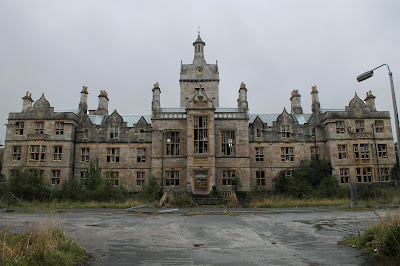



























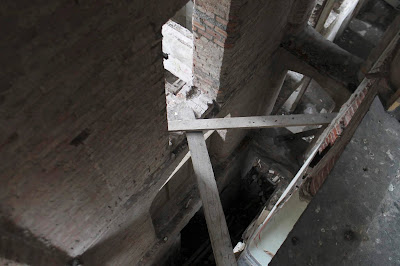




















































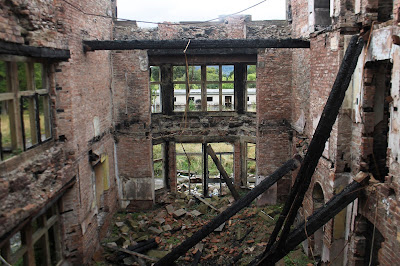






















































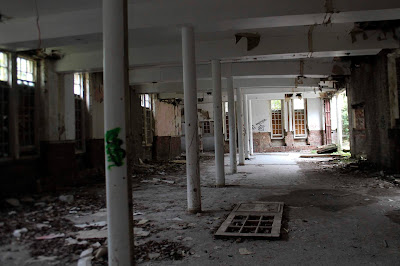
















































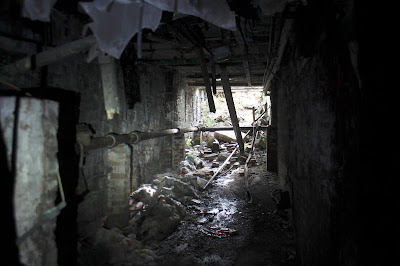










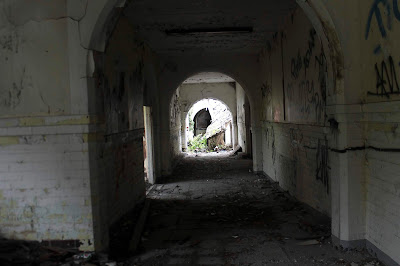































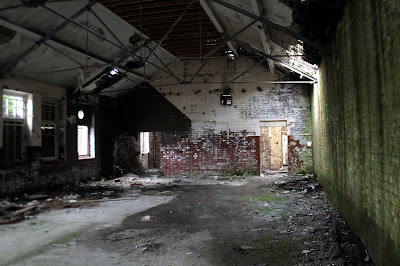


















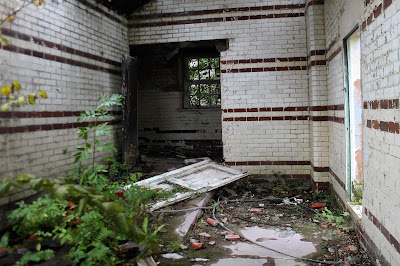




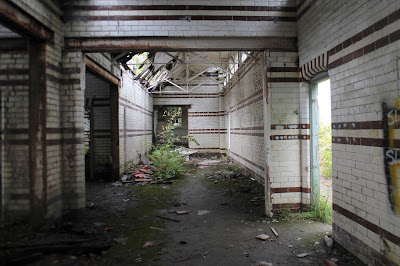


















































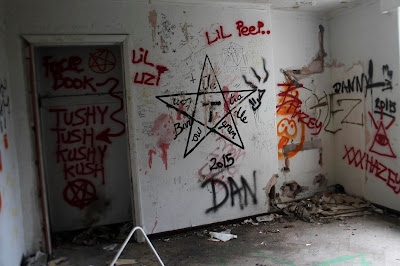




No comments:
Post a Comment